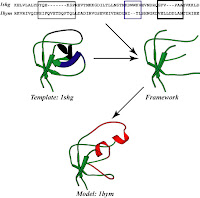
Modelling a protein through automatic comparative modelling servers
May 11, 2007>> Choosing a suitable template sequences
>> Algining template and target sequences
>> Building backbone
>> constructing loop and generating side chains
Finding suitable template is usually done by performing a BLAST search against the sequences in the PDB, the respoistory for protein sturcture obtained by X-ray crystallography and NMR. All sequences in the PDb with an E-value of Blast below a certain treshold are considered as candidates for the template. The alignment between template and target sequences should atleast contain 30% identities and most important it should have existence of conserved regions. A mulitple sequence alignment with same family members of the template or several template sequences may also be constructed. This step requires some manual correction of the alignment in order to obtain a reliable model.Several methods are used for loop building and side chain reconstruction.

When no suitable template is available for comparative modeling, de novo modeling methods (also called ab initio modeling) may be used. The success rate with such modeling is considerably lower than that with comparative modeling. The accuracy of de novo models is too low for problems requiring high-resolution structure information.”
Automatic Comparative modelling servers















